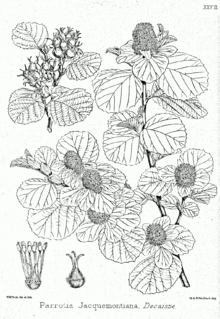False parrotia
| False parrotia | ||||||||||||
|---|---|---|---|---|---|---|---|---|---|---|---|---|

False parrotia ( Parrotiopsis jacquemontiana ) |
||||||||||||
| Systematics | ||||||||||||
|
||||||||||||
| Scientific name | ||||||||||||
| Parrotiopsis jacquemontiana | ||||||||||||
| ( Decne. ) Rehder |
The false parrotia ( Parrotiopsis jacquemontiana ) is a shrub or small tree from the witch hazel family (Hamamelidaceae). The twigs are star-haired, the leaves initially star-haired and later balding. The fragrant flowers grow in small heads that are surrounded by white bracts. The distribution area is in western Himalaya. The wood is used to make handles, walking sticks and bed frames, and baskets are woven from the twigs.
description
The false parrotia is a deciduous, upright up to 7 meter high shrub or tree with star-haired shoots and gray to gray-green branches. The winter buds have two bud scales. The terminal buds are up to 1 centimeter long, the side buds remain smaller and have a short stalk. Both have two bud scales. The leaves are arranged alternately. The stipules are ovate, 3 to 5 millimeters long and fall off early. The petiole is 6 to 12 millimeters long and permanently star-haired. The leaf blade is obovate to rounded, 5 to 8 inches long and clearly serrate. The upper side of the leaf is initially sparsely hairy, the underside is thicker and permanently hairy along the leaf veins . The autumn color is matt yellow to golden yellow.
The hermaphroditic and fragrant flowers grow in small terminal and short-stalked heads , which are surrounded by several white, 1.5 to 2 centimeters long, protruding bracts with brown, star-haired undersides . The calyx is densely hairy and bell-shaped, the calyx lobes are small. Petals are missing. 15 yellow, upright stamens with 3 to 4 millimeter long stamens are formed per flower . The ovary is densely hairy woolly. The fruits are about 1 centimeter long, two-seeded, horned capsules that open through four flaps. The seeds are 5 to 6 millimeters long, elliptical, brown and shiny.
The false parrotia blooms from March to May.
The number of chromosomes is 2n = 24.
Distribution and location requirements
The natural range is in the West Himalayas in the east of Afghanistan, in India in the union territories of Jammu and Kashmir and Ladakh as well as in the state of Himachal Pradesh and in the north of Pakistan. The false parrotia grows in steppes and dry forests on fresh, slightly acidic to slightly alkaline, sandy-loamy to loamy, moderately nutrient-rich soils in light to partially shaded, cool to cold locations. The species is frost hardy . The distribution area is assigned to winter hardiness zone 6b with mean annual minimum temperatures of −20.5 to −17.8 ° C (−5 to 0 ° F).
Systematics
The false parrotia ( Parrotiopsis jacquemontiana ) is the only species of the monotypical genus Parrotiopsis in the witch hazel family (Hamamelidaceae). There the genus is assigned to the tribe Fothergilleae in the subfamily Hamamelidoideae. The species was first scientifically described in 1844 by Joseph Decaisne as Parrotia jacquemontiana ( Basionym ) . Alfred Rehder placed them in the genus Parrotiopsis in 1929 . Another synonym of the species is Parrotiopsis involucrata C. K. Schneid. The generic name Parrotiopsis is derived from the generic name of the ironwood tree Parrotia and the Greek opsis for "appearance". The specific epithet jacquemontiana honors the French explorer Victor Jacquemont (1801–1832).
use
The wood is solid and is used to make handles, walking sticks and bed frames. Baskets are woven from the branches. The species is sometimes used as an ornamental shrub due to its decorative and fragrant flowers and striking autumn colors .
swell
literature
- Andreas Roloff , Andreas Bärtels: Flora of the woods. Purpose, properties and use. With a winter key from Bernd Schulz. 3rd, corrected edition. Eugen Ulmer, Stuttgart (Hohenheim) 2008, ISBN 978-3-8001-5614-6 , pp. 439-440.
- Jost Fitschen : Woody flora . 12th, revised and expanded edition. Quelle & Meyer, Wiebelsheim 2007, ISBN 3-494-01422-1 , p. 624 .
- Helmut Genaust: Etymological dictionary of botanical plant names. 3rd, completely revised and expanded edition. Nikol, Hamburg 2005, ISBN 3-937872-16-7 , pp. 312, 461 (reprint from 1996).
Individual evidence
- ↑ Illustration from D. Brandis: Illustrations of the Forest Flora of North-West and Central India , W. and H. Allen and Co., London, 1874 ( online )
- ↑ German name after Roloff et al .: Flora der Gehölze , p. 439
- ↑ a b c d Roloff et al .: Flora der Gehölze , pp. 439–440
- ↑ Fitschen: Gehölzflora , p. 624
- ↑ a b Parrotiopsis jacquemontiana . In: Flora of Pakistan Vol. 2. www.eFloras.org, November 17, 2005, accessed November 15, 2012 (English).
- ^ Parrotiopsis jacquemontiana at Tropicos.org. In: IPCN Chromosome Reports . Missouri Botanical Garden, St. Louis
- ↑ a b c Parrotiopsis jacquemontiana . In: Germplasm Resources Information Network (GRIN). United States Department of Agriculture, accessed November 15, 2012 .
- ^ Parrotia jacquemontiana . In: Germplasm Resources Information Network (GRIN). United States Department of Agriculture, accessed November 16, 2012 .
- ↑ Exactly: Etymological Dictionary of Botanical Plant Names , p. 461
- ↑ Exactly: Etymological Dictionary of Botanical Plant Names , p. 312
Web links
- Parrotiopsis jacquemontiana. In: The Plant List. Retrieved November 15, 2012 .
- Parrotiopsis jacquemontiana at Plants For A Future . Retrieved November 16, 2012.
- Search result Parrotiopsis jacquemontiana. flickr, accessed November 16, 2012 (photos).

